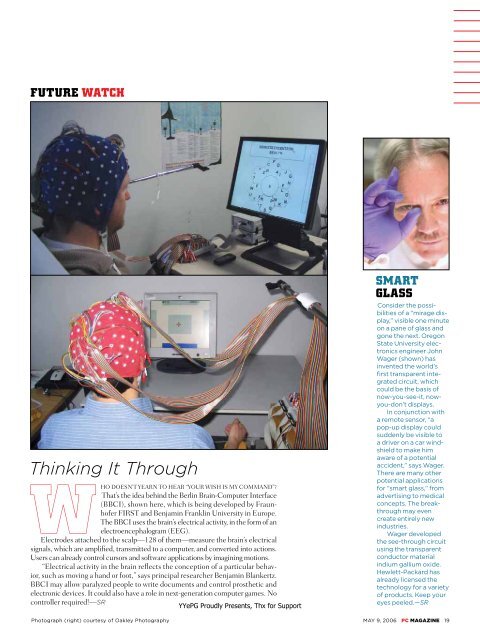Unauthorized - Parent Directory - Support
Unauthorized - Parent Directory - Support
Unauthorized - Parent Directory - Support
You also want an ePaper? Increase the reach of your titles
YUMPU automatically turns print PDFs into web optimized ePapers that Google loves.
FUTURE WATCH<br />
Thinking It Through<br />
WHO DOESN’T YEARN TO HEAR “YOUR WISH IS MY COMMAND”?<br />
That’s the idea behind the Berlin Brain-Computer Interface<br />
(BBCI), shown here, which is being developed by Fraunhofer<br />
FIRST and Benjamin Franklin University in Europe.<br />
The BBCI uses the brain’s electrical activity, in the form of an<br />
electroencephalogram (EEG).<br />
Electrodes attached to the scalp—128 of them—measure the brain’s electrical<br />
signals, which are amplified, transmitted to a computer, and converted into actions.<br />
Users can already control cursors and software applications by imagining motions.<br />
“Electrical activity in the brain reflects the conception of a particular behavior,<br />
such as moving a hand or foot,” says principal researcher Benjamin Blankertz.<br />
BBCI may allow paralyzed people to write documents and control prosthetic and<br />
electronic devices. It could also have a role in next-generation computer games. No<br />
controller required!—SR<br />
YYePG Proudly Presents, Thx for <strong>Support</strong><br />
Photograph (right) courtesy of Oakley Photography<br />
SMART<br />
GLASS<br />
Consider the possibilities<br />
of a “mirage display,”<br />
visible one minute<br />
on a pane of glass and<br />
gone the next. Oregon<br />
State University electronics<br />
engineer John<br />
Wager (shown) has<br />
invented the world’s<br />
first transparent integrated<br />
circuit, which<br />
could be the basis of<br />
now-you-see-it, nowyou-don’t<br />
displays.<br />
In conjunction with<br />
a remote sensor, “a<br />
pop-up display could<br />
suddenly be visible to<br />
a driver on a car windshield<br />
to make him<br />
aware of a potential<br />
accident,” says Wager.<br />
There are many other<br />
potential applications<br />
for “smart glass,” from<br />
advertising to medical<br />
concepts. The breakthrough<br />
may even<br />
create entirely new<br />
industries.<br />
Wager developed<br />
the see-through circuit<br />
using the transparent<br />
conductor material<br />
indium gallium oxide.<br />
Hewlett-Packard has<br />
already licensed the<br />
technology for a variety<br />
of products. Keep your<br />
eyes peeled.—SR<br />
MAY 9, 2006 PC MAGAZINE 19


